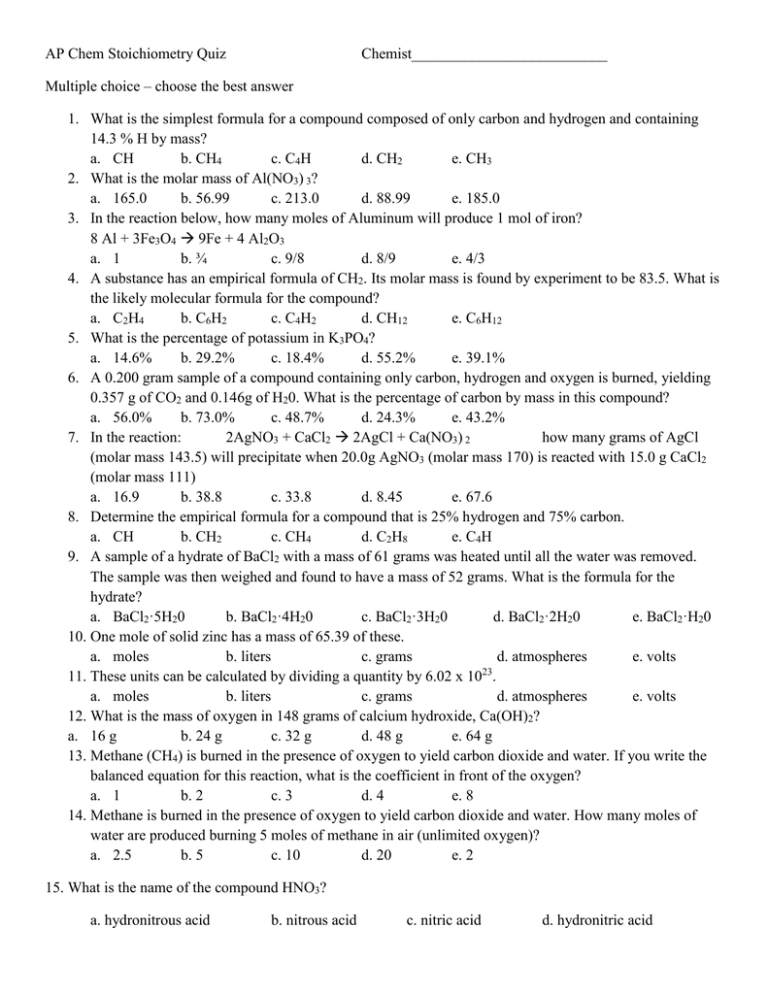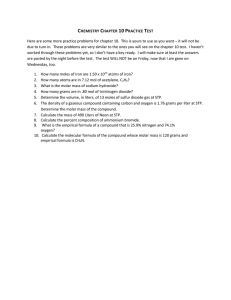09-10 AP Chem Stoichiometry Quiz
advertisement

AP Chem Stoichiometry Quiz Chemist__________________________ Multiple choice – choose the best answer 1. What is the simplest formula for a compound composed of only carbon and hydrogen and containing 14.3 % H by mass? a. CH b. CH4 c. C4H d. CH2 e. CH3 2. What is the molar mass of Al(NO3) 3? a. 165.0 b. 56.99 c. 213.0 d. 88.99 e. 185.0 3. In the reaction below, how many moles of Aluminum will produce 1 mol of iron? 8 Al + 3Fe3O4 9Fe + 4 Al2O3 a. 1 b. ¾ c. 9/8 d. 8/9 e. 4/3 4. A substance has an empirical formula of CH2. Its molar mass is found by experiment to be 83.5. What is the likely molecular formula for the compound? a. C2H4 b. C6H2 c. C4H2 d. CH12 e. C6H12 5. What is the percentage of potassium in K3PO4? a. 14.6% b. 29.2% c. 18.4% d. 55.2% e. 39.1% 6. A 0.200 gram sample of a compound containing only carbon, hydrogen and oxygen is burned, yielding 0.357 g of CO2 and 0.146g of H20. What is the percentage of carbon by mass in this compound? a. 56.0% b. 73.0% c. 48.7% d. 24.3% e. 43.2% 7. In the reaction: 2AgNO3 + CaCl2 2AgCl + Ca(NO3) 2 how many grams of AgCl (molar mass 143.5) will precipitate when 20.0g AgNO3 (molar mass 170) is reacted with 15.0 g CaCl2 (molar mass 111) a. 16.9 b. 38.8 c. 33.8 d. 8.45 e. 67.6 8. Determine the empirical formula for a compound that is 25% hydrogen and 75% carbon. a. CH b. CH2 c. CH4 d. C2H8 e. C4H 9. A sample of a hydrate of BaCl2 with a mass of 61 grams was heated until all the water was removed. The sample was then weighed and found to have a mass of 52 grams. What is the formula for the hydrate? a. BaCl2·5H20 b. BaCl2·4H20 c. BaCl2·3H20 d. BaCl2·2H20 e. BaCl2·H20 10. One mole of solid zinc has a mass of 65.39 of these. a. moles b. liters c. grams d. atmospheres e. volts 23 11. These units can be calculated by dividing a quantity by 6.02 x 10 . a. moles b. liters c. grams d. atmospheres e. volts 12. What is the mass of oxygen in 148 grams of calcium hydroxide, Ca(OH)2? a. 16 g b. 24 g c. 32 g d. 48 g e. 64 g 13. Methane (CH4) is burned in the presence of oxygen to yield carbon dioxide and water. If you write the balanced equation for this reaction, what is the coefficient in front of the oxygen? a. 1 b. 2 c. 3 d. 4 e. 8 14. Methane is burned in the presence of oxygen to yield carbon dioxide and water. How many moles of water are produced burning 5 moles of methane in air (unlimited oxygen)? a. 2.5 b. 5 c. 10 d. 20 e. 2 15. What is the name of the compound HNO3? a. hydronitrous acid b. nitrous acid c. nitric acid d. hydronitric acid 16. What if the correct formula for Copper (II) nitrate? a. CuN b. Cu3N2 c. CuNO3 d. Cu(NO3) 2 e. Cu2NO3 17. How many significant figures are in the number 0.00423050? a. 4 b. 5 c. 6 d. 8 e. 9 18. Which of the following is equivalent to 5.60 x 10-4? a. 56000 b. 56000. c. 0.00056 d. 0.000560 e. 5.60 Chemist:_______________________________ Open Response – Please show all work and include units throughout the problem, when appropriate. 1. Maleic acid is an organic compound composed of 41.39 % C, 3.47 % H and the rest oxygen. If 0.129 mol of maleic acid has a mass of 15.0 g, what are the empirical and molecular formulas of maleic acid? 2. Consider the reaction H2 + O2 H20 5.00 grams of hydrogen gas are reacted with 56.00 grams of oxygen gas. a. Balance the equation. b. Find the limiting reagent. c. Find the theoretical yield of water for this process. 3. Consider the following unbalanced chemical reaction: P4 + F2 PF3 How many grams of F2 are needed to produce 120 grams of PF3 is the reaction has a 78.1 % yield?



